A Breath
2023-2024
artistic collaboration
*
artistic collaboration *
« This installation is composed as an image that invites the visitor to a haptic, olfactory and accoustic experience. Immersed in the semi-darkness of the space, the visitor encounters the evidence of an investigation into the traces of a a scent of the platosaurus's breath. Combining contemporary art with palaeontology, botany with the reconstitution of an odour, this project, developed in an interdisciplinary protocol, proposes an encounter with the Triassic animal through the power of its breath. In the same way, this experience invites us to turn our attention to the air we breathe, which passes through us and emerges transformed from our bodies, participating in the composition of a shared atmosphere created by the breathing of humans and non-humans, from the distant times of the Triassic and even beyond.»
Anaïs Tondeur
Context : invitation to create the olfactory component of Anaïs Tondeur’s installation for the temporary exhibition Plateosaure, this is a dinosaur, presented at the Muséum d'Histoire naturelle in Neuchâtel (CH)
Co-creation with : Anaïs Tondeur, visual artist
Contribution of : Grégoire Bosset, assisted by Dimitri Siig (development and production); Aurèle Louis (sound composition); Roland Salesse (neurobiology of olfaction, INRA); Marc Higgin (anthropologist, CRESSON, CNRS).
The Prix Expo 2024 was awarded to the Muséum d'Histoire naturelle of the City of Neuchâtel.

Plateosaurus. Credits : MNHN

Macerates of pine tree, fern and horsetail. Credits : Sarah Adatte

Process of reconstructing the scent. Credits : Carole Calvez

Platoaurus Project. Credits : Carole Calvez and Anaïs Tondeur.

View of the installation. Credits : ANAIS TONDEUR
Reconstruction of the central scent of the installation: the breath of the Plateosaurus, comprising:
A weeks-long maceration of horsetails and ferns, plants closely related to those that made up the animal’s diet
olfactory evaluation and development of the first fragrance formula, based on the scent notes of the macerates—evoking candied lemon, fish skin, mushroom, and turpentine
Additional tasks carried out:
creation of two supplementary scent profiles (earthy and herbaceous)
Drafting of a scenographic brief
Study of olfactory perception within the space: selection of materials, diffusion devices, and their placement; exploration of how to spatially control the diffusion of breath and exhalation
Description of the olfactory installation :
In a darkened room, devoid of any signage indicating the presence of a scent, visitors were subtly prepared to detect a faint aroma through the presence of an olfactory curtain placed at the entrance— serving as the first scent signal, that of earth. A very light herbaceous note then lingered in the air, fading as the “breath” was released, only to reappear later. A mist visualized the exhalation and the perception of the creature’s breath. The goal was to trick the visitor’s brain in order to ensure a fully immersive and successful sensory experience.